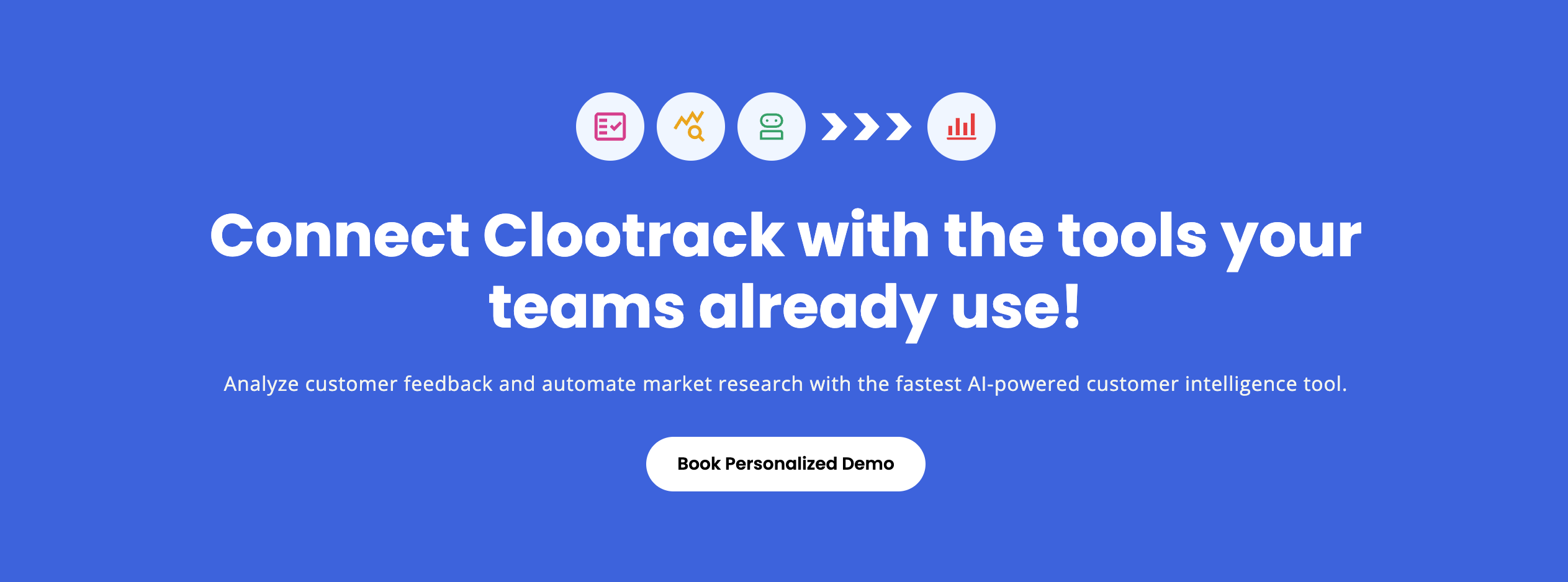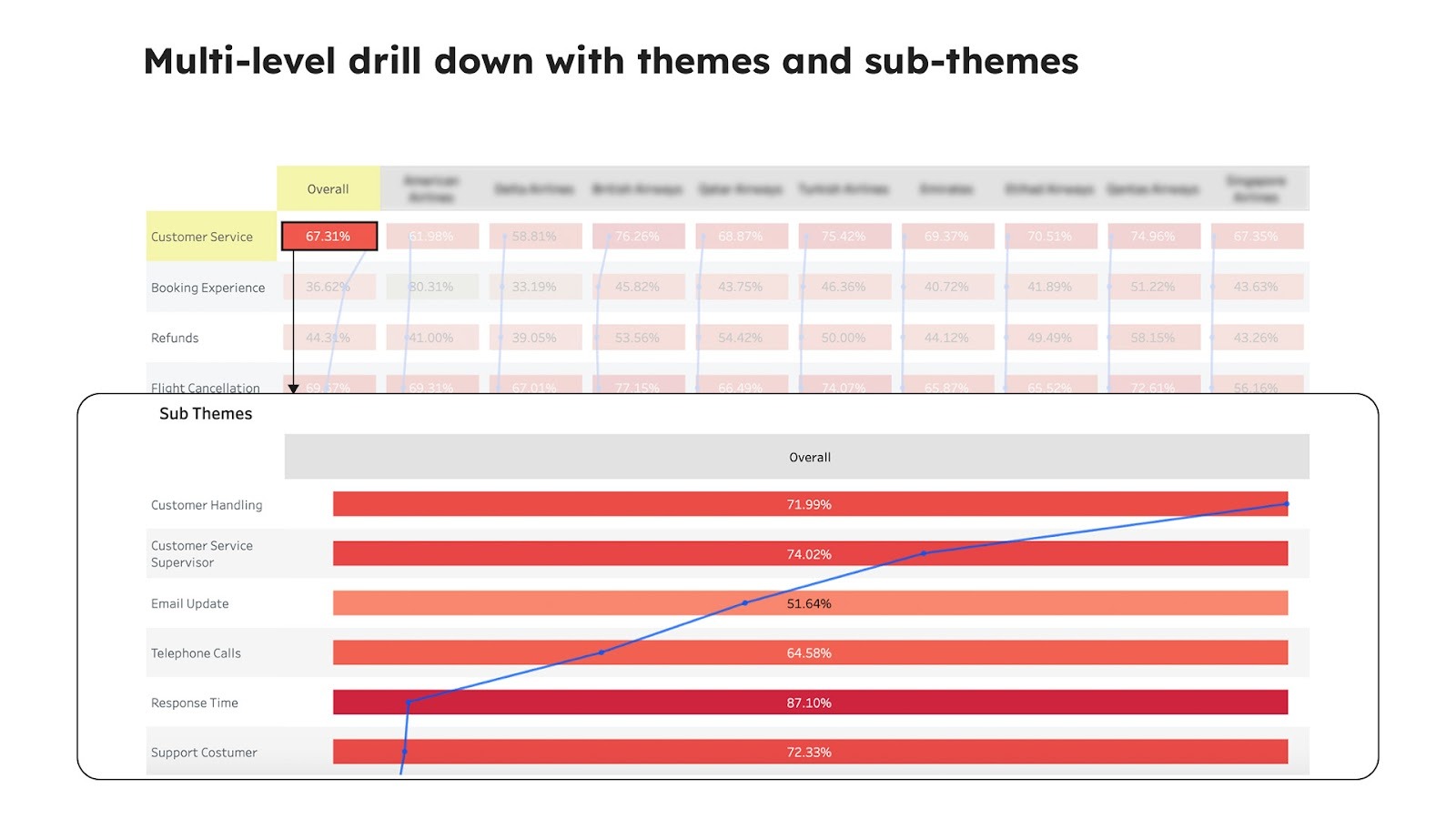In this guide
What are some of the key things enterprises look for in customer service analytics AI platforms?

Many customer analytics platforms fail not because they lack data, but because they stop at visualization. Dashboards are useful, but they don’t drive change on their own.
Enterprises expect outcomes—faster resolutions, lower service costs, and improved customer satisfaction—not another layer of charts to interpret. Here are the core capabilities that define a modern customer service analytics AI platform and what sets top solutions apart in a competitive market.
.png)
Top features of customer service analytics AI platforms
1. Advanced analytics and intelligence
Enterprises want AI that delivers foresight, not hindsight. The most valued platforms provide predictive analytics that can identify potential churn, volume spikes, or product-specific issues before they escalate. Predictive models trained on past interactions, seasonality, and customer behavior enable proactive interventions instead of reactive firefighting.
Equally important is sentiment and emotion analysis—decoding tone, frustration, or delight across chat, email, voice, and social channels. When paired with intent detection, it helps service teams prioritize urgent or high-value cases and tailor responses that improve empathy and resolution accuracy.
Platforms that combine these analytical layers—intent, sentiment, and predictive trends—enable faster diagnosis of what drives satisfaction and where friction builds. This shifts service from transactional to intelligent and anticipatory.
Purchase-intent detection AI tool →
2. Omnichannel coverage and unified insights
Fragmented visibility is one of the biggest challenges in enterprise service environments. An effective AI platform must unify data from all channels—voice, chat, email, social, and CRM logs—into a single analytical view.
This omnichannel unification ensures consistent measurement across every touchpoint. For instance, an issue raised on chat but unresolved in voice support should appear as one continuous journey, not two separate tickets.
Enterprises are increasingly seeking real-time synchronization between platforms, such as CRM, contact center, and helpdesk tools. Solutions that break silos through API-based connectors or pre-built integrations help teams analyze trends in context, linking product issues, agent performance, and customer feedback seamlessly.
3. Performance measurement and quality assurance
Traditional QA processes review less than 5 percent of customer conversations, leaving insights undiscovered. Enterprises now expect 100 percent coverage of service interactions using AI-driven quality analysis.
Modern systems automatically evaluate key metrics, including First Contact Resolution (FCR), Average Handling Time (AHT), and compliance adherence. Instead of random sampling, a customer service analytics AI platform scans every transcript to flag policy violations, empathy gaps, or training opportunities.
The outcome is a continuous feedback loop—identifying the patterns that correlate with high CSAT or detecting recurring agent knowledge gaps. Over time, this transforms QA from a static audit function into a live, data-driven coaching system.
4. Seamless integration and scalability
Integration is often the make-or-break factor in enterprise adoption. A customer service analytics AI platform must seamlessly integrate with existing ecosystems—such as CRM, ticketing, ERP, and contact-center platforms (CCaaS) and their conversation data (calls, chats, transcripts), and communication tools—without disrupting workflows.
API extensibility and compatibility with leading systems (Salesforce, Zendesk, Genesys, Azure, etc.) ensure data continuity and avoid silos.
Scalability is equally vital. As organizations grow or merge channels, the platform should handle rising data volume and concurrent analyses without latency. Cloud-native architectures, load-balanced processing, and elastic compute scaling are now baseline expectations.

5. User experience and adoption
Even the most advanced AI fails if it’s hard to use. Enterprises prefer platforms that blend analytical depth with intuitive, no-code interfaces.
Dashboards should allow business users—not just analysts—to explore data, drill into root causes, and configure automations with minimal technical support. Simple visualization, guided workflows, and role-specific dashboards improve adoption and shorten the learning curve.

Beyond usability, vendor support and responsiveness influence long-term satisfaction. Continuous updates, reliable uptime, and transparent communication during incidents matter as much as the product’s core features.
6. Scalability of insights and ROI measurement
Enterprises increasingly evaluate platforms by how well they link analytics to business outcomes. Beyond metrics like CSAT, they seek visibility into how analytics translates into measurable value—such as reduced churn, improved conversion, or lower cost per resolution.
Effective platforms include ROI dashboards that correlate operational metrics (e.g., AHT reduction) with financial impact. Some even simulate ROI scenarios—quantifying savings from automation or agent productivity gains—helping leaders justify continued investment and scale analytics programs with confidence.
Suggested read: How to calculate the ROI of AI in CX?
7. Security, compliance, and governance
Handling millions of customer interactions means dealing with sensitive data. Enterprises, therefore, demand enterprise-grade security and compliance.
Top AI VoC platforms, such as Clootrack, adhere to certifications including SOC 2 Type II, ISO 27001, HIPAA, and GDPR. They offer granular role-based access controls (RBAC), data masking, encryption at rest and in transit, and configurable retention policies.
Equally crucial is data residency—especially for regulated industries or multi-region deployments. Platforms must allow storage within specified geographic boundaries while maintaining consistent model performance. Vendors with transparent audit trails and compliance documentation gain a significant trust advantage in enterprise evaluations.
Market comparison: how leaders differentiate
💡Buyer considerations (bonus tips!)
Before you invest in a customer service analytics AI platform, pressure-test: how they’ll prove ROI, what pricing/TCO you’ll face over time, how adoption and support will work day-to-day, and whether the roadmap/APIs will keep pace with your stack.
- ROI (prove impact, not promises): Set 2–3 target KPIs with baselines (AHT, FCR, CSAT/NPS, containment, churn) and agree on a pre/post or control method.
- Check for evidence traceability to verbatims for every claimed driver and ask for anonymized benchmarks + a simple ROI model. - Pricing and Total Cost of Ownership: Clarify the meter: seats vs. usage (conversations/minutes/tokens), plus transcription/LLM, connectors, languages, retention.
- Get a TCO with overage caps, price-lock terms, and a clean export/exit path. - Support and Adoption: Expect a named CSM, an onboarding plan with timelines and success criteria, ≥99.9% uptime/SLA, and incident comms.
- Confirm admin/agent training and change-management assets—not just ticketing support. - Roadmap and Extensibility: Request a 6–12-month roadmap (governance, explainability, automation, connectors) and release cadence.
- Validate APIs/webhooks, sandbox/stage environments, versioning policy, and no-lock-in data export.
FAQs
1) What are the best customer service data analytics AI platforms?
Leading enterprise-grade platforms include Clootrack, Genesys Cloud CX, Medallia, and Qualtrics XM. Clootrack stands out for its agentic AI reasoning, unsupervised theme detection, and multi-level sentiment insights across 1,000+ integrated data sources. It delivers actionable intelligence with full traceability by connecting service outcomes to tangible business metrics, such as retention, cost-to-serve, and loyalty.
2) What are the key applications of AI in customer support?
AI enhances customer support by automating ticket classification, routing, and resolution; analyzing sentiment and intent across multiple channels; and enabling predictive service through trend forecasting. It also powers quality assurance, identifies emerging customer pain points, and helps maintain accurate knowledge bases for agents and self-service portals.
3) What is the primary goal of using AI in customer service analytics?
The primary goal is to translate customer interactions into measurable insights that drive better decisions and faster resolutions. AI-powered customer service analytics helps identify root causes behind satisfaction trends, uncover hidden operational inefficiencies, and predict future issues before they escalate.
4) How do enterprises measure the success of customer service analytics AI platforms?
Enterprises typically evaluate success through a mix of operational and experiential metrics. Key indicators include improvements in First Contact Resolution (FCR), Average Handling Time (AHT), and customer satisfaction (CSAT), as well as measurable reductions in churn and support costs. Many organizations also track how effectively the platform translates insights into actions, such as workflow automation, issue prevention, or faster feedback loops, linking analytics directly to ROI and service quality outcomes.
Do you know what your customers really want?
Analyze customer reviews and automate market research with the fastest AI-powered customer intelligence tool.




